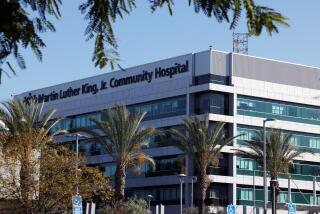Townsfolk first-aid saves ailing Texas hospital : They defy the nationwide crisis in rural health care, and dig deep to resuscitate home-owned facility.
- Share via
LAMPASAS, Tex. — Nearly 60 years ago, the two doctors in this scrappy central Texas town decided they would build a hospital, and even the Great Depression would not stop them.
Because many people didn’t have money to help pay for the hospital’s construction, H.B. Rollins and W. M. Brook accepted donations--building materials and bed linens, for instance--in exchange for future credit on medical bills. For payment, they also accepted whatever a family might be able to offer; around the plains of Lampasas, where the land supports more sheep than people, that often meant taking some livestock instead of cash.
Rollins-Brook Community Hospital, a squat building made of native Texas limestone, still stands on Key Avenue, the town’s main street, but the Depression years were easier for it than the 1990s. In June, after months of financial struggle, the 21-bed hospital closed when the company that owned it defaulted on a loan.
Now another generation of Lampasas residents is rallying around the hospital, and they believe that even a nationwide crisis in rural health care will not stop them.
On Dec. 18, Rollins-Brook hospital is scheduled to reopen, having been bought by Lampasas, population 6,135, solely with donations from residents and town businesses.
“We were determined we were not going to lose that doggone hospital,” said Jack Calvert, a retired army colonel who is the town’s mayor.
In only a few weeks, Lampasas raised more than $300,000 in donations, more than half of the $510,000 price to buy and refurbish the hospital. The biggest single donation was $60,000 and was given anonymously. The community expects to have the rest of the money raised by year’s end. The hospital is being leased and managed as a nonprofit operation by Adventists Health System/Sun Belt, the health care arm of the Seventh-day Adventists.
With its effort, Lampasas is defying current convention, especially in this state, which leads the nation in rural hospital closures. Texas accounted for a fifth of all such closings across the nation over the last decade, and more than a fifth of the state’s rural hospitals have ceased operation in the last five years. Many of those that remain open are in precarious situations; in 1988, 62% of Texas’ rural hospitals reported negative net incomes.
Communities faced with a failing hospital often establish a special tax to keep it open; the community that relies on donations is rare, said Sylvia Boeder, director of the American Hospital Assn.’s rural hospitals section in Chicago.
But Lampasas officials didn’t want to stake the hospital’s future on a tax that might not have passed. Instead, they turned to something more reliable: townspeople’s generosity.
The campaign consists of little more than flyers and a committee, whose members urge fellow residents to contribute. Townspeople have taken to writing checks before committee members have a chance to stop by.
Lampasas, a town without a movie theater or bowling alley, has learned what it’s like to be without a hospital.
There was fear when Rollins-Brook closed. The average resident is 57 years old, and three nursing homes are in business.
Two of the town’s largest employers, Design Foods and LTV Energy Products, began talking about leaving when the hospital closed. And the hospital, with 64 people on its payroll, was one of the town’s major employers.
Morris K. Patteson, one of two doctors in Lampasas, believes that lives have been lost because of the half-hour drive to the nearest medical facilities in Burnet to the south or Killeen to the east.
“At least once a month, we lose somebody because of it,” he said.
Patteson, whose father also was a Lampasas physician, says he has sometimes arrived too late at the hospitals in neighboring towns to deliver the babies of his patients. And his workdays, which were about 12 hours long before the hospital closed, have stretched to 16 or 17 hours.
The county’s ambulance workers are tired, too. People show up on the doorstep of the county ambulance service headquarters as if it were an emergency room. Calls to the ambulance service more than doubled the month the hospital closed.
Dale DeShazo, who works at First National Bank in Lampasas, said that he was ambivalent about the project until an elderly friend needed emergency medical care.
“We almost lost him on that trip,” said DeShazo, recalling the trip that took them by Rollins-Brook on the way to Burnet. “What if that had been one of my children or my wife? I think that really brought the point home.”
Tough times won’t come to an end when the hospital reopens and tries to rely on the limited resources of the town’s retirees, many of whom are on Medicare.
Carlyle Walton, the hospital’s new administrator, says the system will work because of the managing company’s nonprofit approach.
And he senses a new commitment to the hospital. “People feel they own a piece of this now,” he said.
More to Read
Sign up for Essential California
The most important California stories and recommendations in your inbox every morning.
You may occasionally receive promotional content from the Los Angeles Times.













